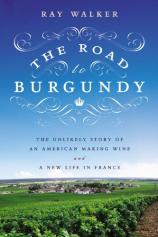The Road to Burgundy: The Unlikely Story of an American Making Wine and a New Life in France
Review
The Road to Burgundy: The Unlikely Story of an American Making Wine and a New Life in France
What employee who detests his job hasn’t fantasized about pursuing a dream vocation? Easier said than done, of course, especially in a bad economy. To perform the feat, you’d need not just a burning passion but also family support, financial backing, and a wine cask overflowing with serendipity. That doesn’t happen often, but how nice when it does. It happened to Ray Walker, a 31-year-old native Californian who dreamed about becoming a winemaker in France’s storied Burgundy region. Walker overcame numerous obstacles, including his lack of winemaking experience and inability to speak French, and became the first American ever to produce two of the most prized Burgundies available, Chambertin and Charmes-Chambertin. THE ROAD TO BURGUNDY is Walker’s account of his transformation.
The most fascinating part of Walker’s story is that, for a long time, he didn’t even like wine. His parents didn’t drink it during his childhood. He assumed that wine “was just an inefficient way to get drunk,” and that it couldn’t be any good because “it had the same ingredients as Welch’s grape juice.” When Walker was growing up, food was for sustenance, not for savoring. And why, he wondered, would you ever drink alcohol while you ate? Maybe a beer now and then, but why anything else?
"[T]he Ray Walker we meet here is a charming man with an infectious love of his chosen craft. Readers who share his passion for fine wine will be entertained by his detailed descriptions of the winemaking process."
That attitude changed when he met his future wife, Christian, also a student at San Francisco State University. She graduated and become a probations officer; Walker dropped out after his junior year to join his parents’ real estate business. On a visit to Florence during the Italian trip in which they got engaged, they ordered wine with one of their meals. Walker doesn’t identify the wine, but it had “a pretty, strawberry-flesh color to it and it smelled intensely of fruit, herbs, and smoke.” This was the moment in which he realized that wine could be a beautiful accompaniment to a meal. “The purpose,” Walker writes, “was simply to enjoy it.”
Soon, he bought tasting wheels to match grape types with aromas, flavors and colors, “expensive crystal glasses for every grape types,” plus decanters, corkscrews and suction devices for resealing opened bottles. He learned the proper way to aerate a wine. And then, fate: Walker and Christian attended a Burgundy tasting at The Wine Club in San Francisco. The young man who led the tasting taught them about the wine’s four classification levels: Bourgogne, village, premier cru, and grand cru, the last being the best. Walker savored “the lacy sweetness of honeysuckle” of one Burgundy and the “tangier, richer pineapple” of another. He learned that holding chilled wines in his mouth intensified the notes (flavors), and that there are subtle but vast differences in taste among the wines of the region’s many terroirs. This was a wine unlike any he had ever tasted. He knew then that he wouldn’t be content to just drink Burgundy. He wanted to make it.
By this time, Ray had left his parents’ business and was studying to become a securities representative at Merrill Lynch. But he found the life of “monitors and memos and bad coffee, suits and ties, and central air” unfulfilling. He left his well-paying job before completing the course and, with Christian’s encouragement, began working in a local winery. Soon, he was cleaning wine barrels and standing “inside of tanks with freezing cold water up to my knees.” And loving every second of it.
Most of the book is devoted to Walker’s brief American apprenticeship and his subsequent and ultimately successful attempt to purchase Burgundy grapes from French courtiers (grape brokers) and work as a winemaker in France. The writing throughout THE ROAD TO BURGUNDY is workmanlike rather than evocative. Walker’s prose can be melodramatic during dialogue exchanges: “Her voice softened, her eyes focused on mine.” And some sentences are awkward, as in, “Eric pushed his mouth to one side of his face as he thought about the different growers.”
But the Ray Walker we meet here is a charming man with an infectious love of his chosen craft. Readers who share his passion for fine wine will be entertained by his detailed descriptions of the winemaking process. There’s not a lot of local color here, at least not to the extent of, say, Peter Mayle’s A YEAR IN PROVENCE. A more expansive portrait of life in the French countryside would have made this a stronger book. Still, it’s hard to imagine a more likable guide.
Reviewed by Michael Magras on July 11, 2013
The Road to Burgundy: The Unlikely Story of an American Making Wine and a New Life in France
- Publication Date: July 11, 2013
- Genres: Nonfiction
- Hardcover: 320 pages
- Publisher: Gotham
- ISBN-10: 1592408125
- ISBN-13: 9781592408122




